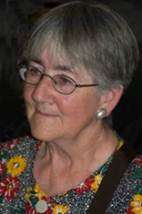Judith M. Lumley
| Judith Mary Lumley AM | |
|---|---|
|
Judith Lumley at her retirement celebration, 2009 | |
| Born |
Judith Mary Casey 15 February 1941 Cardiff, Wales |
| Residence | Melbourne, Australia |
| Fields |
|
| Institutions | |
| Alma mater | |
| Thesis | The uses of scalp blood collection in the study of the human fetus (1971) |
| Known for |
|
| Notable awards |
|
| Spouse |
|
Judith Mary Lumley had a career as an academic, author, public health advocate and perinatal researcher,[1] retiring as Professor Emerita at La Trobe University in December 2008.[1][2] She was born Judith Mary Casey in Cardiff, Wales in 1941[3] and married Peter Lumley in 1964.[4] Lumley graduated from Cambridge University.[5] She emigrated to Australia in 1965 where she studied medicine,[6] gaining her PhD in fetal physiology from Monash University.[1]
Lumley worked in academic teaching and research in both pediatrics and obstetrics and gynecology for several years, before establishing and directing the Victorian Perinatal Data Collection in 1982.[1] In 1988, she chaired the Victorian Ministerial Review of Birthing Services.[1] In 1991 she established a research centre at Monash University, which later moved to La Trobe University.[1][7] Lumley was director of that Centre until 2008, with the exception of two years as Director of the National Perinatal Epidemiology Unit at Oxford University (1994-1995).[1] Originally called the Centre for the Study of Mothers' and Children's Health, it was later named Mother and Child Health Research,[1] with the name changed to the Judith Lumley Centre in 2013.[8]
Judith Lumley has published research in a variety of disciplines and methods, including epidemiology, evaluation of effectiveness and qualitative research. She was an early and longtime contributor to the development of the Cochrane Collaboration.[1] Lumley has three sons.[1]
Education
Lumley graduated first from Cambridge University in 1962[5] and then completed a medical degree at Monash University in Melbourne, Australia.[1] She gained her PhD in fetal physiology working on fetal acidosis in labor[3] at the Monash Department of Obstetrics and Gynaecology,[1] and became a Fellow of both the UK and Australian Faculties of Public Health Medicine and Professor at La Trobe University.[1]
Medical journal editorship
Lumley was co-editor of the Australian and New Zealand Journal of Public Health from 2000 to 2008,[1][2] and also edited Australian Family Physician for several years.[1]
Books
- Birth Rites, Birth Rights: Childbirth alternatives for Australian parents - by Judith Lumley and Jill Astbury (1980).[9]
- Prepregnancy care: A manual for practice - edited by Geoffrey Chamberlain and Judith Lumley (1986).[10]
- Having a baby in Victoria: Final report of the Ministerial Review of Birthing Services in Victoria - Chaired by Judith Lumley (1990).[11]
- Missing voices: The experience of motherhood - by Stephanie Brown, Jill Astbury, Judith Lumley, Rhonda Small (1994).[12]
Awards and honors
Lumley is a life member of the Public Health Association of Australia.[13] Life membership is granted for "exemplary service to the Association." [13]
In 2002, Lumley was awarded the Sidney Sax Public Health Medal, for "more than two decades of work dedicated to the promotion of public health and for her efforts in improving maternal care in Australia." [14] This medal is the Public Health Association of Australia's pre-eminent prize for a person who has made a "notable contribution" to public health in Australia.[14] It is competitive and awarded annually.[14]
Lumley was awarded a position in the 'Smart 100' in 2003.[15] This was a list of "the smartest, most innovative and most creative" people in a variety of fields in Australia organized by The Bulletin magazine.
Lumley was appointed a Member of the Order of Australia in 2005, cited "for service to promoting public health and improving maternity care in Australia."[16]
The Faculty of Health Sciences of La Trobe University established the Judith Lumley Scholarship for high-achieving higher degree students in maternal and child health research.[1]
In 2013, the name of Mother and Child Health Research at La Trobe University was formally changed to the Judith Lumley Centre.[8]
References
- 1 2 3 4 5 6 7 8 9 10 11 12 13 14 15 16 Public Health Association of Australia. "Emeritus Professor Judith Lumley AM" (PDF). Public Health Association. Retrieved 14 November 2013.
- 1 2 Editors (2009). "Appreciation and thanks to Judith Lumley". ANZ Journal of Public Health. 33 (1): 5. doi:10.1111/j.1753-6405.2009.00330.x.
- 1 2 "Births March 1941". BMD Vol 11a. FreeBMD. p. 652. Retrieved 16 November 2013.
- ↑ "Marriages December 1964". BMD Vol 10c. Free BMD. p. 55. Retrieved 16 November 2013.
- 1 2 Lumley, Judith; Wood, Carl (1973). "Unexpected oxygen tensions in fetal acidosis". Journal of Perinatal Medicine. 1 (3): 166–173. doi:10.1515/jpme.1973.1.3.166.
- ↑ Lumley, Judith (1980). "The Image of the Fetus in the First Trimester". Birth. 7 (1): 5–14. doi:10.1111/j.1523-536X.1980.tb01359.x.
- ↑ "VicHealth- Centres of Excellence". VicHealth. Retrieved 17 November 2013.
- 1 2 Judith Lumley Centre. "Name change and new research program". La Trobe University. Retrieved 14 November 2013.
- ↑ Lumley, J; Astbury, J (1980). Birth Rites, Birth Rights: Childbirth alternatives for Australian parents. West Melbourne, Victoria, Australia: Sphere.
- ↑ Chamberlain G, Lumley J, ed. (1986). Prepregnancy care: A manual for practice.
- ↑ Having a baby in Victoria: Final report of the Ministerial Review of Birthing Services in Victoria. Melbourne: Health Department Victoria. 1990.
- ↑ Brown, Stephanie; Astbury, J; Lumley, J; Small, R (1994). Missing voices: The experience of motherhood. Melbourne: Oxford University Press.
- 1 2 Public Health Association of Australia. "What we do / Life members". Public Health Association of Australia. Retrieved 13 November 2013.
- 1 2 3 Public Health Association of Australia. "Sidney Sax Public Health Medal". Public Health Association of Australia. Retrieved 13 November 2013.
- ↑ "Australia's Smart 100". Bulletin Magazine. 22 October 2003. Retrieved 16 November 2013.
- ↑ Australian Government. "It's an Honour: Australians celebrating Australians". Australian Government. Retrieved 13 November 2013.
